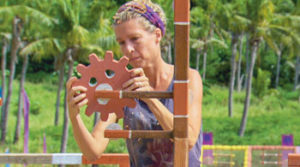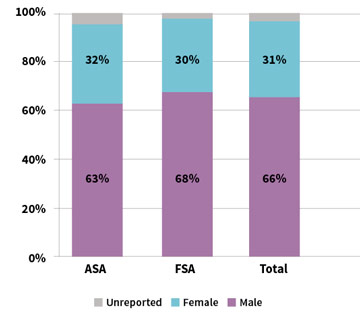The Climb to the Top
From the business world to reality TV, bias may—or may not—be present
August/September 2018At one point in my career, I was thrilled to have gotten a “big break.” My boss’s boss invited me to give a very technical presentation on my work to a group of executive vice presidents. I was thrilled, nervous and excited! When I walked into the room, I was the only woman. My boss’s boss put his arms around me, kissed me on the lips, and said to the group of male executives, “Aren’t I lucky I get to hire girls that look like this?” My work and accomplishments had been undermined by this introduction before I even started talking. It seemed that my gender and appearance had precluded my ability.
This situation is interesting because, on paper, our office was demographically diverse, with solid representation of gender, race, ethnicity, age, religion and other demographics. So, given a diverse slate, why would diversity issues still be present? Didn’t we solve that? Clearly, diversity issues are not “solved” by simply ensuring representation from varying demographic groups. But it is probably impossible to define specific criteria to discover when bias is truly present.
Now consider this experience: At one point in my life, I was thrilled to have gotten a “big break.” After many years of applying, I had finally been invited to play CBS’s Survivor! Touted as “the greatest social experiment on television,”1 Survivor is one of the most successful reality television shows of all time. I was thrilled, nervous and excited! Within the first couple of hours on the island, my young and beautiful tribemates formed an immediate “Core Four” alliance, referring to me and the other 46-year-old woman as the “Mom Squad.” My loyalty and challenge potential had been rejected before I had a chance to prove either. It seemed that my gender and appearance had precluded my ability.
But was this bias? Probably not.
The Diversity Conundrum
The two situations described seem similar, yet they illustrate why diversity issues are so difficult to understand and dissect. Sometimes we need to look not only at the numbers, but also at the way people are made to feel. In the business example, I felt completely disrespected. In the Survivor example, I felt my tribemates were simply making their best predictions of how to keep the tribe physically strong.
Despite the complexity of the diversity issue, most would agree that we do not solve a diversity problem by simply ensuring representation from varying demographic groups. True diversity is achieved when varying backgrounds, experiences, races, ethnicities, ages, genders, sexual orientations, marital status and [pick any descriptive group you like] are fairly represented as a result of people being judged solely on the basis of their performance and contributions, and it is an inclusive environment. Is this possible in a business setting? How?
Demographic-blind Business Practices
There are many reasons I love being an actuary, but one of these is that the exam process is blind to demographics. Exam candidates are assigned a number, and graders know only the unique number. They do not know gender, race, ethnicity, national origin, age, marital status or any other identifying characteristic. You could be a purple alien sitting for an exam, and that would be unknown to the graders. Thus, our actuarial qualifications are based solely on our knowledge of the subject matter and our ability to express that knowledge.
Can organizations structure work processes to similarly reduce inherent bias? Yes, they can and should. Consider the often-cited example of orchestra auditions. Back in the 1970s, major orchestras generally were made up of only 5 to 10 percent women. By the late 1990s, the percentage of women in orchestras had quadrupled to about 25 to 30 percent. The reason for the change? The introduction of gender-blind auditions.2 Candidates would audition for the orchestra behind a screen. Much like the actuarial exam graders, the judges have no information on the demographics of a candidate (many women would even remove their shoes to avoid the telltale sounds of a woman’s shoes influencing the decision). The judges would make their selections based on ability alone.
SURVIVING SURVIVOR
In the game of Survivor, immunity and reward challenges are developed to be inherently demographic blind. During my season (Heroes vs. Healers vs. Hustlers), castaways balanced on floating structures in the ocean, stacked blocks, shot slingshots, built block towers with our feet, pulled marbles out of bags and unscrambled words. Winning immunity and rewards was based on ability. It didn’t matter if the player was male or female, single or married, white or of color, young or old, tall or short.

Photograph: Screen grab/CBS
Organizations can and should take steps to minimize bias in a business setting. For example, consider replacing names on resumes with candidate numbers during the hiring process. It is possible that background information could reveal or infer demographics (i.e., Eagle Scout versus Gold Award), but it’s a start. Age bias could potentially be eased if college graduation year was removed from the resume. Years of experience could infer age, but experience is relevant and graduation year is not.
Of course, once an interview is scheduled and executed, demographics become known. But the initial impression would shift toward evaluation based on ability and qualifications. To ease potential bias at the interview stage, interviewers and those who make hiring decisions should be trained to recognize and avoid unconscious bias. “Likeability” has been extensively studied,3 and one of the known factors that influences likeability is similarity. If we are more likely to like people who are similar to us, then we are also more likely to hire people who are similar to us. Training can help ease this basic human tendency so that we can hire based on qualifications, potential and other role-related attributes.
The Pipeline Issue
But considering the orchestra example, why do blind auditions lead to just 25 to 30 percent women in the orchestra? Why not 50 percent? Well, even with the most airtight, unbiased business practices in place, organizations may still be struggling with a pipeline issue—that is, a non-diverse pipeline of candidates entering the field in the first place. A recent study conducted on behalf of the Society of Actuaries (SOA), The Actuarial Foundation, the Casualty Actuarial Society (CAS) and the International Association of Black Actuaries (IABA) identified multiple factors that inhibit a diverse pipeline of actuarial candidates, including financial barriers with respect to exam fees, lack of mentors and lack of awareness of the profession at the high school level.4
Figure 1: SOA Members by Gender,
as of Dec. 31, 2017

Source: Society of Actuaries
In fact, SOA membership statistics confirm that despite our demographic-blind exam grading process, our profession still largely comprises white men. (See Figure 1.)
While 98 percent of members self-reported gender, only roughly 11 percent of SOA members self-reported race/ethnicity, preventing publication of statistically relevant details. However, census data for actuaries, which can be used for benchmarking, may suggest that potentially only about one-fourth of members are people of color. As our actuarial organizations continue to focus on improving the pipeline for underrepresented groups, we are seeing positive progress. Whether we’re talking about actuaries or orchestras, without a fully diverse pipeline of candidates, even the most unbiased business practices cannot erase a diversity issue.
Demographic Bias and the No-win Situation
Suppose we are able to correct the pipeline and the representation issue. Now, have we solved that diversity problem? Maybe not. We may still have some work to do to ensure inclusion, which may be defined as ensuring the right conditions are in place for every individual to achieve his or her full potential, while feeling welcomed and equally treated. Inclusion may refer to demographic differences and experiential differences like educational background, tenure, personality and training.

Photograph: Robert Voets/CBS
In fact, sometimes even when the organization itself works diligently to implement all the right policies and practices, the employees themselves may inadvertently foster a noninclusive environment. Consider the game of Survivor, where the cast is carefully and thoughtfully constructed to represent diverse demographics and experiences. Here, the players themselves can unwittingly create potential barriers. Consider this observation from one castaway about another (me), based only on visual cues, before the game even began:
“Moms honestly don’t do that well in the show, so I’m not really scared of her [Chrissy Hofbeck]. … If I could, I’d take her to the end with me, because it doesn’t matter how good she is. People are not going to look at her like a threat and people are not going to respect her at the end, even if she plays a perfect game.” —Survivor Castaway, pre-game interview5
Older moms, like one of my fellow castaways articulated in her pre-game opinion of me, do not often win Survivor. While this could be based on strategic or social weakness, fans of the game have nicknamed the phenomenon the “mom curse.” The idea suggests that if an older mom makes the final three by mastering the social game (building strong relationships and making good impressions), then the jury members may assume she is “just a mom” and award the win to the player sitting next to her. If she masters the strategic game (blindsiding players, controlling the vote and otherwise playing competitively), then the jury may be offended by her behaving in a manner inappropriate for mothers, again awarding the win to the player sitting next to her. People are not going to look at her like a threat and people are not going to respect her at the end, even if she plays a perfect game.
Ageism in the workplace is reminiscent of the Survivor mom curse. Hiring managers may be reluctant to hire an older candidate, because even if the older candidate has exactly the right qualifications, intelligence may be questioned (why did it take him or her so long to get to this level?). Professionalism may be questioned (will the older person have a problem reporting to a younger person?). There may be concern that the older person is overqualified for the role, and the hiring manager may not want a direct report who is more experienced. Is it the “older person curse”? People are not going to look at him or her like top talent, and people are not going to respect his or her work product, even if he or she is the perfect hire.
Consider moms versus dads versus childless adults in the workplace. Employees may view a working mom leaving work early to attend her child’s sporting or school event negatively (she does not place a high enough priority on work). Yet a man leaving work early to attend his child’s sporting or school event may be viewed positively (he is dedicated to both work and family). Employees without children may feel they don’t even have permission to leave work early to attend a close friend or family member’s event at all. It’s important to note that these feelings may be misguided, as company policy and procedure may indicate equality in each of these situations—but inclusion relates to a feeling of fairness and acceptance.
There are all-too-frequent stories of working moms feeling as if they were passed up for posh assignments without even being asked, on the assumption that “she wouldn’t want it.” Unmarried employees may be leaned on to work excessive overtime, justified because, “They don’t need to go home to kids.” Some employees may choose to hide personal situations, yet we’ve learned that the “don’t ask, don’t tell” concept isn’t a solution; it’s a cover-up. Additionally, those who can’t bring their complete self to work (or feel they need to mask their “real” self) may suffer and may not be able to contribute as fully as they could have if they didn’t need to hide a piece of themselves.
Unconsciously Undermining the Ultimate Goal
Raising awareness of unconscious bias is a necessary step to eliminating it. However, given that the human mind is incapable of ignoring an idea that is brought to its attention (“think of a pink elephant”), do organizations face additional complications when raising awareness of unconscious bias? Do they risk increasing the prevalence of that bias?
Some years ago, I attended a leadership meeting for my organization, and human resources was presenting on its extensive diversity efforts. It was proudly announced that all open positions and promotions would consider a diverse slate (women and people of color must be included in the interview circuit and promotion recommendations). Additionally, qualifications could be relaxed to attract more women and people of color and fulfill this goal.
Wow! I was almost on-board, but then this last part, I felt, did women and people of color a great disservice. To me, the comment suggested that women and people of color must not be as inherently talented as white men. Additionally, I did not aspire to be identified explicitly as a female actuary, but instead as a great actuary. I stated my displeasure with the inference, and many other leaders agreed. No one wants to feel that they won or lost a job due to a diversity effort.
Moving Forward
Ultimately, dealing with diversity and inclusion issues takes work, but it is something we must continue and improve upon. As a woman working in a male-dominated STEM field, I am invigorated by my work. I love being an actuary, and I’m thrilled that I chose this great profession. I’m proud to see the various actuarial organizations working together toward a common goal of building a diverse profession that reflects the racial, ethnic and gender mix we represent. And as an older mom, I’m so grateful that I had an opportunity to play the great game of Survivor, and to prove that an older mom can truly excel in the game.
I choose to be joyful in our successes instead of resentful of the hurdles. Together, let’s keep moving forward. Let’s be conscious of making fair decisions in our own organizations and supporting diversity and inclusion efforts. Understanding, accepting and learning to work with others is the ultimate goal. Even if you don’t walk away with $1 million, you can bet you’ll be proud of your game.
References:
- 1. “Survivor: Heroes vs. Healers vs. Hustlers Season Preview.” 2017. Survivor. CBS. ↩
- 2. Goldin, Claudia, and Cecilia Rouse. 1997. “Orchestrating Impartiality: The Impact of ‘Blind’ Auditions on Female Musicians.” National Bureau of Economic Research Working Paper No. 5903. January. ↩
- 3. Cialdini, R. B. 1984. Influence: The Psychology of Persuasion. New York: Harper Collins. ↩
- 4. Society of Actuaries. 2018. “New Report Holds Keys to Diversity and Inclusion.” The Actuary. March. ↩
- 5. Wigler, Josh. 2017. “‘Survivor’ Season 35 Player Profile: Meet Chrissy Hofbeck.” The Hollywood Reporter. September 4. ↩
Copyright © 2018 by the Society of Actuaries, Chicago, Illinois.

